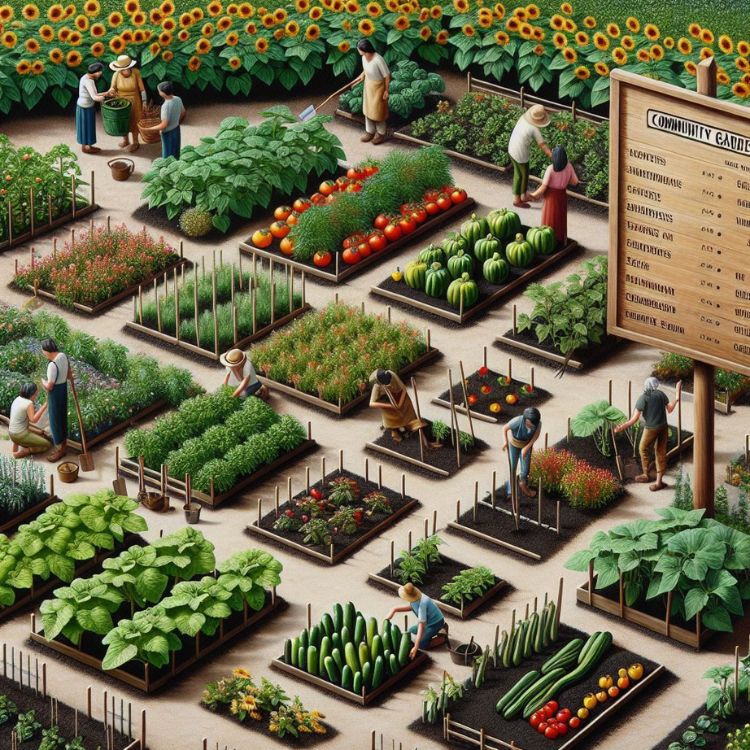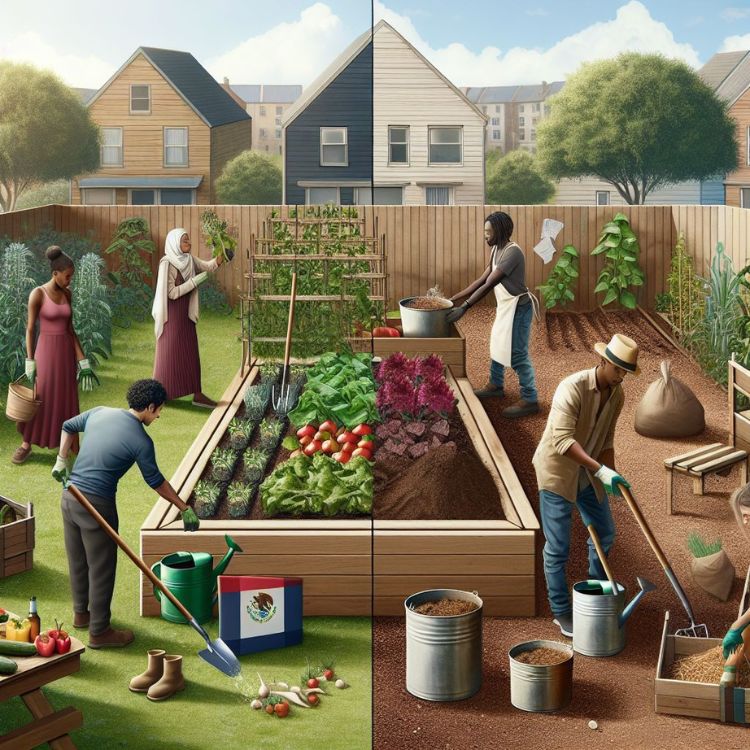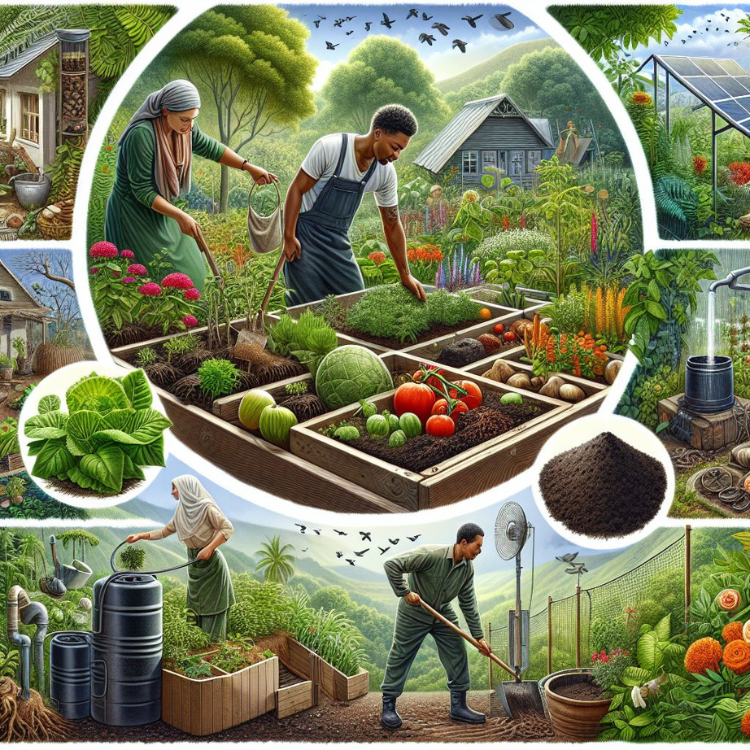
Imagine a place where your community comes together to grow food, learn, and nurture the earth. That’s the power of a community survival garden. It’s not just about planting seeds; it’s about cultivating resilience and togetherness. So, let’s roll up our sleeves and dig into the essentials of setting up a garden that thrives and brings people together.
Key Takeaways
- Identify a suitable location with ample sunlight and easy access to water.
- Form a dedicated team to manage the garden and define clear roles.
- Test and prepare your soil to ensure a healthy growing environment.
- Select a mix of heirloom and hybrid plants for a resilient garden.
- Support your garden’s longevity by investing in quality seeds and tools.
Gear Up for Growth: Assembling Your Community Survival Garden
Setting up a community survival garden is like assembling a puzzle. Every piece is crucial, from the location to the people, and the plants you choose. It’s a journey we embark on together, and the first step is to understand what we’re aiming for—a space that feeds our bodies and souls.
What a Community Survival Garden Can Offer
A community garden is more than just a plot of land; it’s a place where we come together to grow not only vegetables and fruits but also relationships and a sense of belonging. These gardens are a lifeline in times of need, providing fresh produce when it’s scarce and teaching valuable skills that can make all the difference.
Key Elements for a Thriving Garden
Before we break ground, let’s talk about what makes a garden flourish. Sunlight, water, and good soil are the non-negotiables. But we also need a group of dedicated gardeners, a plan for what we’ll grow, and a system to keep things running smoothly. With these in place, we’re on our way to a bountiful harvest.
Plotting Success: Initial Steps for Garden Creation

Choose Your Site Wisely
The right location is the cornerstone of your community survival garden. You’ll want to find a spot that gets plenty of sunlight—at least six hours a day. Water access is critical too; a nearby hose or rain barrel can make all the difference. Also, consider the soil quality and how easy it is for your community to get there. Safety is key, so choose a site that’s secure and welcoming.
- Look for areas with direct sunlight for most of the day.
- Ensure there’s a water source close by to ease the task of watering plants.
- Check the soil condition or be prepared to bring in topsoil or compost.
- Accessibility is vital; make sure the site is easy for all community members to reach.
Once you’ve found the perfect spot, it’s time to get everyone on board. Host a community meeting, share your vision, and listen to what others have to say. Their insights and enthusiasm will be the seeds of your garden’s success. For more detailed guidance, consider reading this how to organize a community garden guide from NC State Extension Publications.
Organize Your Planting Strategy
What you plant should reflect the needs and tastes of your community. Start with easy-to-grow veggies like lettuce, tomatoes, and cucumbers. Then, think about adding herbs and flowers to attract pollinators. But most importantly, choose plants that your neighbors are excited to grow and eat. This is about feeding families and spirits, after all.
Gather Your Garden Squad
No garden grows alone. You’ll need a team to help with everything from planting to harvesting. Look for people who are as passionate about gardening as you are. Then, decide who will do what. You might need a watering chief, a weeding warrior, or a compost queen. Remember, clear roles make for smooth gardening.
- Recruit volunteers with diverse skills and interests.
- Assign specific tasks to team members to ensure all garden duties are covered.
- Regular meetings will keep everyone informed and engaged.
With these initial steps out of the way, you’re well on your way to creating a thriving community survival garden. Remember, this is a journey of growth, learning, and connection. It’s about more than just the food—it’s about the bonds you’ll form and the resilience you’ll build. So take these tips, get out there, and start growing together.
Testing and Amending Soil
Before planting anything, it’s crucial to know what’s going on beneath our feet. Soil testing is the first step. It tells us about pH levels, nutrient content, and any contaminants present. You can grab a testing kit from your local garden store or reach out to an extension service. Once you have your results, it’s time to get that soil into tip-top shape.
Amending soil might sound technical, but it’s just about adding the right stuff to make it fertile. If your soil is too acidic, you might add lime; if it’s too sandy, compost can help it retain moisture. This is where organic matter becomes your best friend. It adds nutrients, improves soil structure, and helps keep plants healthy. Think compost, well-rotted manure, or leaf mold.
Seasonal Considerations
Every season has its stars in the garden. Spring might be for lettuce and peas, while summer loves tomatoes and peppers. When planning your garden, think about what to plant and when. This ensures a continuous harvest and keeps the soil from getting worn out. Also, consider crop rotation; it’s like giving your soil a little vacation, so it’s ready to support the next batch of plants.
Plant Selection Strategies: What to Grow in Your Community Garden
Choosing the right plants for your community garden is like picking your team for a relay race; you need a good mix to reach the finish line. Start with some fast growers like radishes and salad greens to get quick wins and keep everyone excited. Then, add in the staples like carrots, beans, and squash that will fill baskets and bellies in the months to come. For those interested in year-round productivity, consider exploring high-yield survival garden layouts and planning strategies.
Don’t forget about perennials like asparagus and rhubarb. They take time to establish but will reward you year after year. And, of course, herbs! They’re easy to grow, and their flavors can turn a simple meal into a feast. So, let’s choose wisely and create a garden that sustains us through the seasons.
- Start with easy-to-grow crops for quick harvests and motivation.
- Include a variety of plants to ensure a diverse and nutritious yield.
- Consider perennial plants for long-term benefits.
- Grow herbs for their culinary and medicinal values.
Most importantly, involve everyone in the decision-making process. This way, the garden truly becomes a collective endeavor, reflecting the tastes and needs of the community it feeds.
Choosing Plants for Nutrition and Ease of Growth
When it comes to plant selection, nutrition is key. Leafy greens are packed with vitamins, and legumes are a great source of protein. But let’s also think about ease of growth. Some plants are more forgiving than others, which is great for new gardeners. Things like zucchini, chard, and beets are pretty much plant-it-and-forget-it veggies. They’re tough, they’re generous, and they’ll make you feel like a gardening pro in no time.
Heirloom vs. Hybrid: Benefits for Longevity and Resilience
Heirloom plants are the heritage breeds of the garden. They’ve been passed down through generations and are treasured for their flavors and stories. But they’re not just about nostalgia; they’re open-pollinated, which means you can save their seeds for next year’s garden. Hybrids, on the other hand, are the result of careful breeding to bring out the best traits, like disease resistance or uniformity. They’re reliable and often more vigorous. So, what’s the best choice for your garden? A bit of both. Heirlooms bring diversity and tradition, while hybrids offer consistency and robustness.
Collective Effort: Managing Your Garden with Teamwork
Teamwork makes the dream work, especially in a community garden. Everyone has something to offer, whether it’s time, knowledge, or muscle power. Create a schedule that allows people to contribute when they can. Some might be morning people, others night owls. Some might be great at planning, while others excel at getting their hands dirty. By recognizing and utilizing everyone’s strengths, you build not just a garden, but a community.
Scheduling Garden Duties
Keep a calendar for the garden. It might include watering days, weeding weekends, or harvest parties. By scheduling garden duties, everyone knows what needs to be done and when. This way, no plant goes unwatered and no weed takes over. It’s all about staying organized and keeping communication lines open.
Don’t forget to plan for the unexpected, too. Weather can be unpredictable, and so can life. Have a backup plan and a way to reach out to the team in case of last-minute changes. Flexibility and understanding are as important as the garden tools themselves.
Communication is Key
Good communication is the water that keeps the garden of teamwork thriving. Set up a bulletin board, start an email chain, or create a group chat. The important thing is to have a way to share updates, ask for help, and celebrate successes. And remember, every voice matters. When everyone feels heard, they’re more invested in the garden’s success.
Harvesting Hope: Sharing the Bounty

Harvest time is when the garden’s promise comes to fruition. It’s a time of abundance and celebration. But it’s also a time to think about fair distribution. How do you make sure everyone gets their share? Set up a system early on. Maybe it’s a harvest schedule or a sign-up sheet. The goal is to ensure that everyone who contributes gets to enjoy the rewards of their labor.
Equitable Distribution of Produce
Equity in the garden means everyone gets a fair share. It might be based on how much time each person has contributed, or it could be a simple equal split. The key is to decide as a community what feels fair and to stick to it. This way, when the tomatoes are ripe and the carrots are plump, there’s no question about who gets to take them home.
Ensuring Year-Round Food Security
A community survival garden isn’t just for the summer months. With some planning, you can extend the harvest into fall and even winter. Plant cold-hardy crops like kale and brussels sprouts. Consider a greenhouse or cold frames to protect against frost. Preserving the harvest through canning, drying, and fermenting means you can enjoy the garden’s bounty even when the ground is frozen.
Food security is about more than just calories; it’s about nutrition, variety, and access. A well-planned garden can provide all three, making it a cornerstone of community resilience.
- Grow a mix of crops to ensure a continuous harvest throughout the seasons.
- Use season extension techniques to protect crops from early frosts.
- Preserve excess produce to enjoy during the off-season.
By following these tips and working together, your community survival garden will not only be a source of sustenance but also a beacon of hope and cooperation.
Now, let’s talk about the future of your garden. Investing in the right seeds is like choosing the building blocks for your community’s health and resilience. Heirloom seeds are the gems of the garden world. They have been saved and passed down for generations, and they bring with them a resilience and diversity that’s hard to match. These seeds are adapted to local conditions over time, which means they’re often more resistant to pests and diseases.
Invest in Your Garden’s Future with Heirloom Seeds
- Heirloom seeds can produce more nutritious and flavorful crops.
- They are open-pollinated, allowing you to save seeds from year to year.
- By growing heirlooms, you’re helping to preserve genetic diversity.
- These seeds often require less chemical intervention, promoting a healthier ecosystem.
Heirloom seeds also connect us to our agricultural heritage and the stories of gardeners and farmers who came before us. When we plant these seeds, we’re not just growing food for now; we’re keeping history alive and ensuring a rich tapestry of plants for future generations.
Hybrid seeds have their place, too. They’re specifically bred for certain characteristics, like improved yield or disease resistance. While you can’t save seeds from hybrids for future planting, they can be a good choice for certain crops where you want to maximize production or need that extra disease resistance.
In the end, the choice between heirloom and hybrid seeds might come down to your garden’s specific needs and goals. It’s okay to use a mix of both. This way, you get the benefits of heirlooms and the reliability of hybrids. It’s all about finding the right balance for your community garden.
And let’s not forget about the tools of the trade. Good quality gardening tools can make the difference between backbreaking work and a joyful day in the dirt. Invest in sturdy shovels, trowels, and pruners. Look for ergonomically designed tools that will last many seasons. Remember, quality over quantity is the key.
Survival Essentials: Your Partner in Planting
For those looking to purchase high-quality heirloom seeds and gardening tools, Survival Essentials is your go-to resource. They offer a diverse collection of seeds, including rare and traditional varieties that are perfect for community gardens. Their seeds are non-GMO, ensuring that you’re planting pure, natural varieties. Plus, their tools are designed to help you cultivate your garden efficiently and sustainably. For those interested in expanding their medicinal plant knowledge, check out their Survival Garden Seed Kit and invest in the future of your community garden.
FAQs about Community Survival Gardens
How do you select the right location for a community garden?
Choosing the right location for your community garden is critical. Look for a site that receives at least six hours of sunlight daily, has access to water, and is easily accessible to all community members. Safety and security are also important factors. A good location can foster a thriving garden and a strong community bond.
What are the best practices for soil preparation in a survival garden?
Healthy soil is the foundation of a successful garden. Start by getting your soil tested to understand its needs. Then, amend it with organic matter like compost or well-rotted manure to improve its structure and nutrient content. Always aim for a balance of sand, silt, and clay, along with plenty of organic matter for the best growing conditions.
Regularly aerate your soil to allow roots to breathe, and consider using mulch to retain moisture and suppress weeds. Rotate your crops each year to prevent soil depletion and reduce disease and pest problems. These practices will help you build and maintain fertile, productive soil in your community garden.
How do you decide what to plant in a community garden?
Deciding what to plant in your community garden should be a collaborative process. Consider the preferences and dietary needs of the community, as well as the local climate and growing conditions. Start with easy-to-grow crops to ensure early successes, and include a variety of plants to provide a diverse and nutritious yield.
- Involve community members in choosing plants to grow.
- Select a mix of fruits, vegetables, herbs, and flowers to create a balanced ecosystem.
- Consider the growing season and plant varieties that will produce throughout the year.
By involving the community in the decision-making process, you ensure that the garden meets the collective needs and fosters a sense of ownership and pride among all gardeners.
What systems can be implemented for effective garden management?
Effective garden management relies on organization and communication. Implement a system for scheduling garden duties, such as watering, weeding, and harvesting. Use tools like shared calendars, notice boards, or digital apps to keep everyone informed and engaged. Establish clear roles and responsibilities to ensure that tasks are completed efficiently.
How can garden produce be distributed fairly amongst contributors?
Fair distribution of garden produce is essential to maintain a harmonious community. Create a system that reflects the amount of time and effort each member has contributed. This could be a rotational harvest schedule or a points system based on participation. Transparency and open communication about the distribution process will help ensure that everyone feels fairly treated.
Community survival gardens are more than just spaces to grow food; they are places of learning, sharing, and connection. By following these tips and best practices, you can help create a garden that not only provides sustenance but also strengthens the fabric of your community. Remember, every plant grown, every seed sown, is a step towards a more resilient and united neighborhood.






